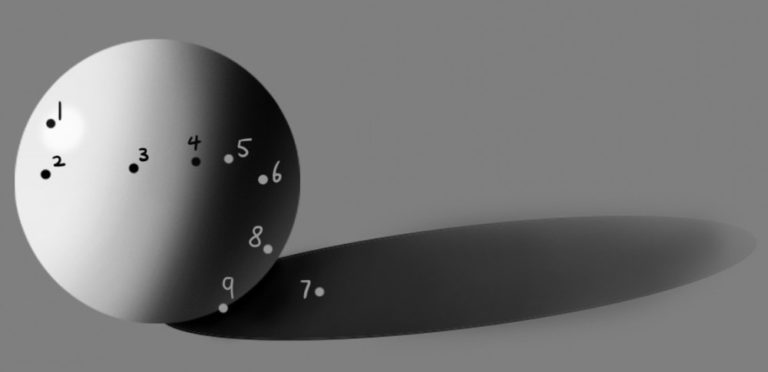
Light and shadow affect the value of colours, and values give an object its form. When drawing something realistically, it is more important to get the values right than to get the colours right. If your values are right and the colours are slightly off, the drawing will still look pretty realistic. If you are not sure what values mean, click here.
In this post, I will show you the basic types of light and shadows that can be found on an object.
There are many types of light and shadows when you look at an object. The classic example is a single light source shining on a ball. The example above has direct sunlight shining on the ball from the top left.
- Highlight
- Center light
- Halftone
- Terminator
- Form shadow
- Core shadow
- Cast shadow
- Reflected light
- Occlusion light
As you can see, there are quite a few things to go through. I shall start off from light to shadows.
Light source
It is the direction at which the light is coming from. There are different types of light sources. Some examples are
Sunlight – the light rays are parallel, evenly spread on an object
Overcast light – the light diffuses, therefore, there is no strong separation of light and shadow.
There can be lots of different light sources depending on the situation. Right now, I’m sitting in my room and typing on my laptop. I have light coming from the sky through my windows, I have the monitor screen emitting light, I also have light coming through the window from a room behind me. The type of light source and material of the object can determine the characteristics of the light and shadows. For example colour, intensity, transparency etc.
For this post, the main example given above only has one primary light source, which will be the sun. This is for simplification as this is just a basic introduction to the types of light and shadows.

The image above has 2 different light sources, one from the left and one from the right. We can tell that by looking at the shadows. There are 2 shadows, one at each side of the tennis ball, thus we can deduct that there are 2 light sources shining on the ball.

The green ball in the above image is translucent. Therefore some light is able to pass through the ball and reach the shadow casted on the floor. This explains the slight greenish colour that you can see on the shadow.
Highlight
The highlight is the brightest part of an object where light reflects into your eyes.
If you move around an object under light, you will notice that the highlight will change in relation to your position.
Center Light
It is the area of an object that faces toward the light source, it is the area that receives the most amount of direct light.
Half/ Mid Tone
This is the area that transitions from center light to the terminator.
This area still receives some light directly from the light source but less than the center light, therefore, this area is darker than the center light.
Terminator
This is the area where light transitions into shadows. It is where the light rays from the light source are parallel to the tangent of the sides.
Form Shadow
This is the shadow area of an object where direct light can no longer reach. This area can still receive reflected light or other light sources.
Core Shadow
The core shadow is the area just next to the terminator in the shadows side. It is usually the darkest part of the form shadow.
Cast Shadow
An objects cast shadow is produced due to the object blocking light from the light source. An objects transparency may affect the intensity or darkness of its cast shadow.
A cast shadow will have a clear and sharp edge if the light source is very strong. But under diffused and soft light, the edge of the cast shadow will be blurry.
In the example image above, we can also see that the further away the cast shadow is from the object, the blurrier the edges and lighter the shadow.
Reflected Light
If you can still remember from your physics lessons, light can bounce off or get absorbed by surfaces. These light are called reflected light. They are a form of secondary light source that can light up shadow areas.
As shown in the example, some light bounced off the table surface and on to the shadow area, which in turn made it look brighter. If the table is red, the reflected light will be slightly red as well.
Occlusion Shadow
It is the darkest part of the cast shadow where forms meet. It is the area with the least amount of light hitting it.
When 2 objects are in contact with each other, the place where they touch will receive very little light as they are very close to each other thus it is difficult for light to shine on that area.
Conclusion
So these are the basic types of light and shadows that can be found on an object under light. By understanding light and shadows and applying them in your drawings, you will be able to produce more realistic looking artworks.
I hope you’ve enjoyed reading this post and have learnt something new.
You may also be interested in:





One Response
Hello Mary.a questionS about the actual colour of an object .where would that actually sit on the object/at what angle to the light source would that begin and end?im thinking would it be between the core shadow and centre light.at about a 45degree angle. also the area called halftone ,do you see that as more of a shadow ,or the influence of the shadow?does that start at 60degree angle to the light?When putting in a base tone is that the actual local color that you see,then slightly desaturated?Thanks.Alan